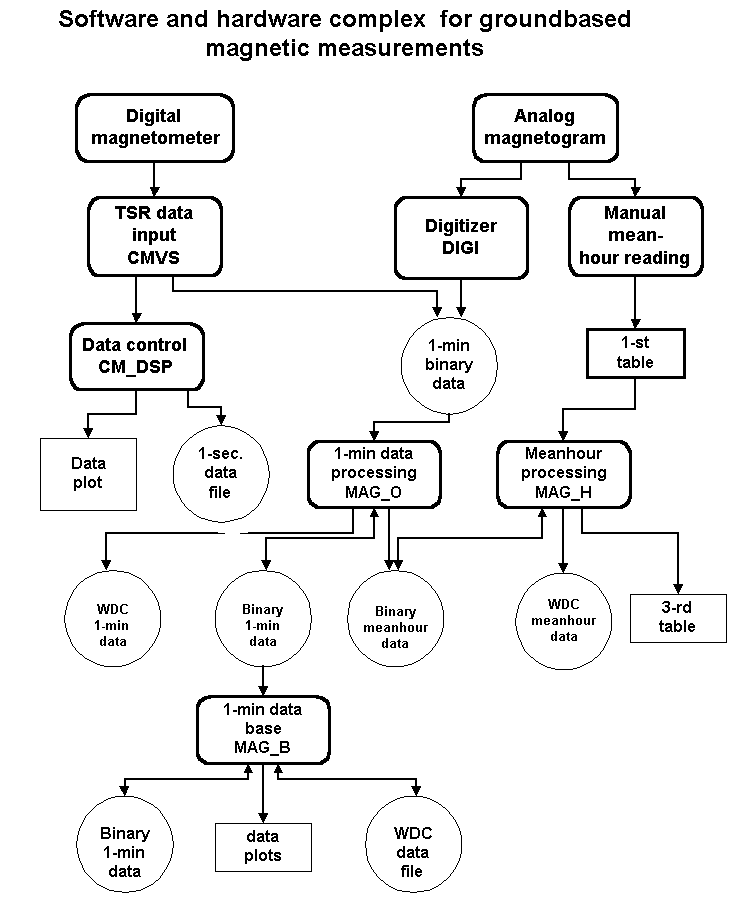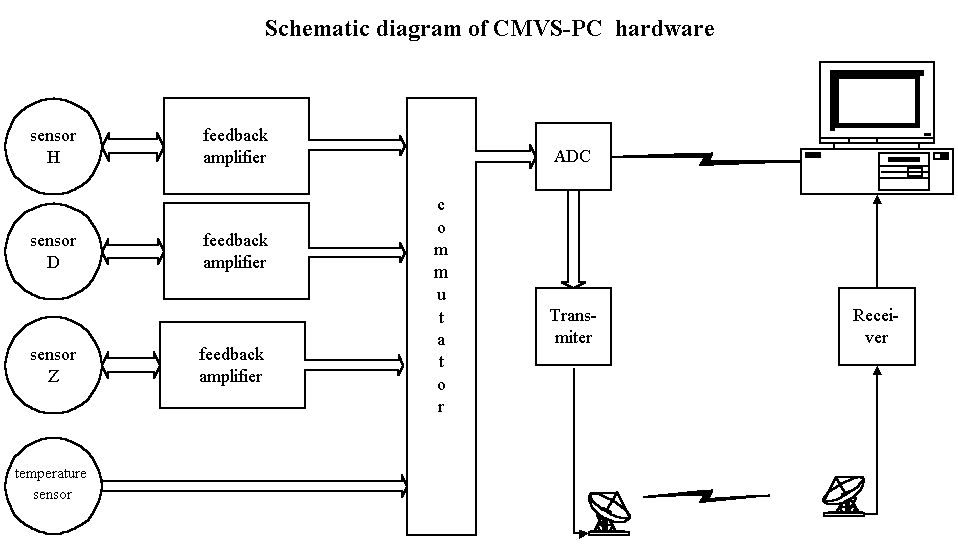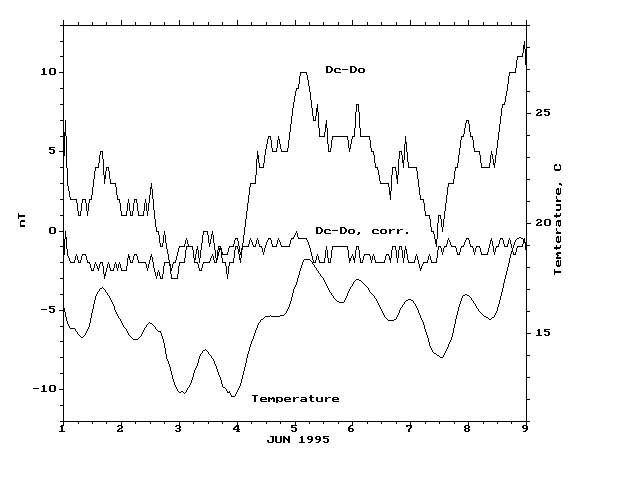
SOFTWARE AND HARDWARE COMPLEX FOR GROUNDBASED MEASUREMENTS OF THE MAGNETIC FIELD VARIATIONS
IZMIRAN, Tpoitsk, Moscow Reg., 142092, RussiaGlobal magnetometer network data are essential for understanding of the Earth current system and are used widely in different magnetosphere-ionosphere studies. Magnetic observatories network is one of the oldest and the most developed observation systems in the word. Now new digital magnetometers are coming in practice, but old magnetometers with photo paper recording still use widely as basic or backup system. Digital magnetometer data and data archives are becoming the main kind of geomagnetic data. Well-known general-purpose data base management programs do not take into account the features of geomagnetic data and cannot process them effectively. So it was developed a special, project oriented hardware and software for groundbase magnetometer data collection and handling.
Fig 1. shows general structure of hardware-software complex for geomagnetic data handling. It can support any types of magnetic sensors with electric output as well as to work with analog magnetograms. Complex can consist of digital magnetometer, analog magnetometer and digitizer. Digital magnetometer includes sensors with electric output and analog-digital converter. Most functions of the magnetometer are carried out by special TSR software, so the price of magnetometer hardware is relatively small. As a result of operation files with 1-min. magnetic data are writing on PC hard drive. In case of analog magnetogram they can be digitized with help of digitizer by special program, which produce 1-min. data file or meanhour value can be taken from magnetogram manually.

Fig. 1. General structure of hardware-software complex for geomagnetic data handling.
One minute data files produced by digital magnetometer or digitizer program are processed by program which do quality control, add base value and so on. This program calculates meanhour value, which can be use as input for meanhour processing program. If there no digital magnetometer or digitizer, 1-st meanhour table can be used as input for meanhour processing
Above mention programs allow to work with data of separate observatory. But usually later on data of separate stations must be combined in frame of some project (for example GM-145 or Equatorial Electrojet) with word wide network data from WDC's added to data set. WDC systems now have powerful computers and complex data base systems to handle data. Geomagnetic observatories, as a part of general data collection system also need convenient and simple data base management system to handle geomagnetic data. The last part of our software intended for this.
Digital magnetometer CMVS-PS
During 1985-88 SKB FP AN has made more than 50 station CMVS-2. The insignificant part of such station is still in operation, but in basic they have used the resource and morally have become outdated. In stations CMVS-2 and CMVS- 6 quartz sensors are used which have considerably greater service life and cost of which makes a significant part of cost of station. A 1994-95 in branch of the Earth and planets magnetism opportunities as much as possible cheap modernization of stations CMVS-2 and 6 were studied. The goal was put to simplify extreme the hardware and majority of magnetometer functions to realize by a program way. As a result digital magnetometer station CMVS-PC was created. CMVS-PC consists of the block of magnetic sensors (SB), block of analog-digital converter (ADCB) and recording (RB) block. As SB the block of sensors (and cables) of stations CMVS-2 or CMVS -6 is used. Changes in them is not made, i.e. simple replacement CMVS on CMVS-PC is possible. Any other sensors with an analog electric output also can be used. Schematic diagram of CMVS-PC is shown on fig. 2

Fig 2. Schematic diagram of CMVS-PC .
The ADCB consists of, entrance switchboard on 4 channels, the analog-digital converter itself and converter of ADC data to serial code. Three channels are used for measurement of the magnetic field, and to the fourth channel termosensor is connected for measurement of the SB temperature. Including of additional channels for connection to other device with analog electric output is possible
SB places the ADCB in a room near. The information with SB each 0.25 sec. is transferred to RB through twisted pair wire or high-frequency cable or through radio channel in RS-232 format . In a described experienced sample the transfer of data was carried out just through the radio channel. Averaging of the instant values, accumulation of the information, timing of the data are carried out by RB.
The basic parameters of ADCB.
The recording block.
The recording block is realized on the serial computer as IBM-PC completely by a program way. For creation of RB any IBM-AT compatible computer starting from AT-286 model approaches.
The data registration program is loaded constantly in memory (TSR program) and works on interruptions at receipt of each byte of the information. Thus it is possible to use PC as usual computer for processing any other data. The program of registration occupies about 20 Kb of operative memory and its work is completely imperceptible for the user. The sole restriction - the computer should not be switched off. Such mode of work is more favorable for any computer. If a power network is bad (there are the jumps and absent of a voltage) use of any system of a reserve feed is desirable. At absence of such system the data during absence of a power will be lose, but at switching on of the power, the program will be automatically loaded in memory and the registration will proceed. The submitted below results are received without system of a reserve power supply.
The program accepts instant readout and averages them for 1-mines intervals. During averaging reliability of data is checked and erratic values which can be, especially with the use of the radio channel, are excluded from averaging. The 1-min. values collect in memory and each 10 minutes (it is possible to set this time from 1 up to 60 mines) are written down on a disk. There is the separate file for each day on a disk. The same program makes correction of computer clock, providing accuracy + /- 1 sec/day.
Usage of the system during 2.5 months has shown high reliability of system. Totally it was lost 5 minutes of data in July due to rebooting of the program for upgrading, yet 7 minutes of data was lost in August (near the aerial of the receiver the TV set was switching on, the strong interference completely decay reception), and there were a few individual spikes in data because of noise. Thus reliability of registration was very high. On PC, simultaneously with magnetic registration, such program as Norton commander, text editors, Turbo-Pascal and C ++ compilers were using, magnetic data were processing.
The software
Besides the resident program for registration of 1-minute data, a set of the programs for the control, primary and standard data processing are included in a complete set of CMVS-PC
1) The program CMV_DSP provides the control and registration 1-sec. data in real time. At start of this program you see current time, three components of the real time magnetic field (value and plot) and temperature. This program can record 1-second value of the magnetic field on a disk and allow setup computer clock according the signal of exact time.
2) The program CMV_DAY allows to see (overlook) on the plot 1-min. values of a field and temperature written down on a disk.
3) The program CMV_MAG will transform 1-min. data from a format of CMVS-PC record to MAG format. For reduction of the resident registration program size, the data are written down on a disk actually in an ADC format, without any transformation and are not convenient for processing and storage. The format MAG was developed especially for storage and processing of large volumes of 1-min. geomagnetic data.
Results of the test.
The station was installed and started to work in middle of June 1995. The main task of the first stage of operation was the check of reliability of the system.
The sensors were installed on temporary basement in a stone shed, used as a warehouse. Near to the sensors block, the magnetic masses were located and the sensors itself were made for arctic stations. Naturally in such conditions to check up metrological characteristics and long-term stability was impossible, but to do some estimation was possible.

Fig 3. Comparison of digital and analog magnetometer data.
For quality check of data, the difference of hourly average CMVS-PC and hourly average ordinates of analog Central Magnetic Observatory (CMO) magnetograms were calculated (fig. 3, Dc-Do). This difference changes in a range up to + /- 15 ýâ. Under the diagram of a difference on fig. 3, hourly average value of temperature is shown. It is evident almost 100 % correlation of these curves, i.e. this channel of CMVS-PC has temperature factor about 2.5 nT/deg. Certainly, it is very large factor even for the bad quartz sensor and this temperature variation probably connected with temperature variation of the expense of the external reasons (inclination of the basement, moving of magnetic masses, probably temperature factor of ADC and etc.). In our case it is not so important, we are interested in checking the opportunity to remove this variation by a program way. The curve 3 (Dc-Do, corrected) shows a difference of hourly average values CMVS-PC and CMO after correction of CMVS-PC data on temperature factor. Now difference does not exceed +/- 2 nT and corresponds to real accuracy of analog magnetograms digitizing. Thus the continuous registration of temperature allows completely remove errors, connected to presence of temperature drift of sensors (and ADC). Hourly average values of 3 components are presented below.
Data processing
The special software package was developed for preliminary procession of digital geomagnetic data in IZMIRAN. It consists of two parts: for meanhour (MHV) and for 1-min. values with interface between them. In case of MHV package provides convenient data input (including MHV taken from analog magnetograms), with preliminary quality control, graphic data output and comparison with original magnetograms. It also allows to correct errors, to enter absolute measurements, to interpolate base levels shift. Processed data can be printed as standard monthly tables or recorded as file in WDC format.
In case of 1-min. data, package allows one to convert data to common MAG format, to plot and check data, to remove calibration spikes and extraneous data. It also allows including absolute measurements, to subtract linear trend, and so on. Software allows digitizing analog magnetograms to fill gaps in digital record. In both cases it allows to combine data from main and backup magnetometers in one file. Data are stored in binary format, so yearly volume of data can be saved on one 1.2 Mbytes diskette or can be written in WDC format.
This two programs intended for geomagnetic observatory routine work. The next program intended mainly for creating and supporting geomagnetic databases that include data of many stations. It can use for data archiving in the institutes and for data analyses in different studies. Fig 5 shows main menu options of MAG database program. This program is used for many years for archiving and scientific analyses of 1-min. digital geomagnetic data of CMVS-2 and CMVS-6 stations, as well as worldwide data set for the year 1996 of 28 stations for VIKING project.
The above mentioned database allows the ground based geomagnetic data to be more widely applied for magnetospheric studies and increases the efficiency of such investigation. The proposed geomagnetic data format allows us to decrease the volume of data, to speed up their processing, to make the development of programs easier and can be used for geomagnetic data processing and exchange. Extensive use of geomagnetic database software confirms its importance as a tool for the comparative research of ground-based data and the satellite measurements.
Reference
V.G.Petrov, N.I.Juhmankova. Software for digital magnetometer data processing. Preprint IZMIRAN 23(777), 1988.
V.G.Petrov. Ground-base magnetometer data management. Preprint IZMIRAN 59(944), 1990.
J. Ryno, C. Sucksdorff, V. Petrov. Digital geomagnetic data base for VIKING period. IAGA Bull. N 53, 1989.
V.Petrov, A.Zaitzev, J.Runo, H. Nevanlinna, R. Pellinen. VIKING geomagnetic database and software as a tool for research. U.S.STEP Newsletter, Vol 1, N.4, Sept 1991, pp. 8-10.